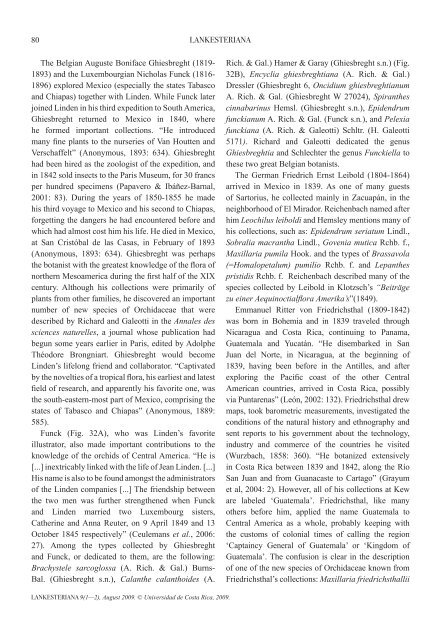orchids and orchidology in central america. 500 ... - lankesteriana.org
orchids and orchidology in central america. 500 ... - lankesteriana.org
orchids and orchidology in central america. 500 ... - lankesteriana.org
You also want an ePaper? Increase the reach of your titles
YUMPU automatically turns print PDFs into web optimized ePapers that Google loves.
80<br />
The Belgian Auguste Boniface Ghiesbreght (1819-<br />
1893) <strong>and</strong> the Luxembourgian Nicholas Funck (1816-<br />
1896) explored Mexico (especially the states Tabasco<br />
<strong>and</strong> Chiapas) together with L<strong>in</strong>den. While Funck later<br />
jo<strong>in</strong>ed L<strong>in</strong>den <strong>in</strong> his third expedition to South America,<br />
Ghiesbreght returned to Mexico <strong>in</strong> 1840, where<br />
he formed important collections. “He <strong>in</strong>troduced<br />
many f<strong>in</strong>e plants to the nurseries of Van Houtten <strong>and</strong><br />
Verschaffelt” (Anonymous, 1893: 634). Ghiesbreght<br />
had been hired as the zoologist of the expedition, <strong>and</strong><br />
<strong>in</strong> 1842 sold <strong>in</strong>sects to the Paris Museum, for 30 francs<br />
per hundred specimens (Papavero & Ibáñez-Barnal,<br />
2001: 83). Dur<strong>in</strong>g the years of 1850-1855 he made<br />
his third voyage to Mexico <strong>and</strong> his second to Chiapas,<br />
f<strong>org</strong>ett<strong>in</strong>g the dangers he had encountered before <strong>and</strong><br />
which had almost cost him his life. He died <strong>in</strong> Mexico,<br />
at San Cristóbal de las Casas, <strong>in</strong> February of 1893<br />
(Anonymous, 1893: 634). Ghiesbreght was perhaps<br />
the botanist with the greatest knowledge of the flora of<br />
northern Meso<strong>america</strong> dur<strong>in</strong>g the first half of the XIX<br />
century. Although his collections were primarily of<br />
plants from other families, he discovered an important<br />
number of new species of Orchidaceae that were<br />
described by Richard <strong>and</strong> Galeotti <strong>in</strong> the Annales des<br />
sciences naturelles, a journal whose publication had<br />
begun some years earlier <strong>in</strong> Paris, edited by Adolphe<br />
Théodore Brongniart. Ghiesbreght would become<br />
L<strong>in</strong>den’s lifelong friend <strong>and</strong> collaborator. “Captivated<br />
by the novelties of a tropical flora, his earliest <strong>and</strong> latest<br />
field of research, <strong>and</strong> apparently his favorite one, was<br />
the south-eastern-most part of Mexico, compris<strong>in</strong>g the<br />
states of Tabasco <strong>and</strong> Chiapas” (Anonymous, 1889:<br />
585).<br />
Funck (Fig. 32A), who was L<strong>in</strong>den’s favorite<br />
illustrator, also made important contributions to the<br />
knowledge of the <strong>orchids</strong> of Central America. “He is<br />
[...] <strong>in</strong>extricably l<strong>in</strong>ked with the life of Jean L<strong>in</strong>den. [...]<br />
His name is also to be found amongst the adm<strong>in</strong>istrators<br />
of the L<strong>in</strong>den companies [...] The friendship between<br />
the two men was further strengthened when Funck<br />
<strong>and</strong> L<strong>in</strong>den married two Luxembourg sisters,<br />
Cather<strong>in</strong>e <strong>and</strong> Anna Reuter, on 9 April 1849 <strong>and</strong> 13<br />
October 1845 respectively” (Ceulemans et al., 2006:<br />
27). Among the types collected by Ghiesbreght<br />
<strong>and</strong> Funck, or dedicated to them, are the follow<strong>in</strong>g:<br />
Brachystele sarcoglossa (A. Rich. & Gal.) Burns-<br />
Bal. (Ghiesbreght s.n.), Calanthe calanthoides (A.<br />
LANKESTERIANA<br />
LANKESTERIANA 9(1—2), August 2009. © Universidad de Costa Rica, 2009.<br />
Rich. & Gal.) Hamer & Garay (Ghiesbreght s.n.) (Fig.<br />
32B), Encyclia ghiesbreghtiana (A. Rich. & Gal.)<br />
Dressler (Ghiesbreght 6, Oncidium ghiesbreghtianum<br />
A. Rich. & Gal. (Ghiesbreght W 27024), Spiranthes<br />
c<strong>in</strong>nabar<strong>in</strong>us Hemsl. (Ghiesbreght s.n.), Epidendrum<br />
funckianum A. Rich. & Gal. (Funck s.n.), <strong>and</strong> Pelexia<br />
funckiana (A. Rich. & Galeotti) Schltr. (H. Galeotti<br />
5171). Richard <strong>and</strong> Galeotti dedicated the genus<br />
Ghiesbreghtia <strong>and</strong> Schlechter the genus Funckiella to<br />
these two great Belgian botanists.<br />
The German Friedrich Ernst Leibold (1804-1864)<br />
arrived <strong>in</strong> Mexico <strong>in</strong> 1839. As one of many guests<br />
of Sartorius, he collected ma<strong>in</strong>ly <strong>in</strong> Zacuapán, <strong>in</strong> the<br />
neighborhood of El Mirador. Reichenbach named after<br />
him Leochilus leiboldi <strong>and</strong> Hemsley mentions many of<br />
his collections, such as: Epidendrum seriatum L<strong>in</strong>dl.,<br />
Sobralia macrantha L<strong>in</strong>dl., Govenia mutica Rchb. f.,<br />
Maxillaria pumila Hook. <strong>and</strong> the types of Brassavola<br />
(=Homalopetalum) pumilio Rchb. f. <strong>and</strong> Lepanthes<br />
pristidis Rchb. f. Reichenbach described many of the<br />
species collected by Leibold <strong>in</strong> Klotzsch’s “Beiträge<br />
zu e<strong>in</strong>er Aequ<strong>in</strong>octialflora Amerika’s”(1849).<br />
Emmanuel Ritter von Friedrichsthal (1809-1842)<br />
was born <strong>in</strong> Bohemia <strong>and</strong> <strong>in</strong> 1839 traveled through<br />
Nicaragua <strong>and</strong> Costa Rica, cont<strong>in</strong>u<strong>in</strong>g to Panama,<br />
Guatemala <strong>and</strong> Yucatán. “He disembarked <strong>in</strong> San<br />
Juan del Norte, <strong>in</strong> Nicaragua, at the beg<strong>in</strong>n<strong>in</strong>g of<br />
1839, hav<strong>in</strong>g been before <strong>in</strong> the Antilles, <strong>and</strong> after<br />
explor<strong>in</strong>g the Pacific coast of the other Central<br />
American countries, arrived <strong>in</strong> Costa Rica, possibly<br />
via Puntarenas” (León, 2002: 132). Friedrichsthal drew<br />
maps, took barometric measurements, <strong>in</strong>vestigated the<br />
conditions of the natural history <strong>and</strong> ethnography <strong>and</strong><br />
sent reports to his government about the technology,<br />
<strong>in</strong>dustry <strong>and</strong> commerce of the countries he visited<br />
(Wurzbach, 1858: 360). “He botanized extensively<br />
<strong>in</strong> Costa Rica between 1839 <strong>and</strong> 1842, along the Río<br />
San Juan <strong>and</strong> from Guanacaste to Cartago” (Grayum<br />
et al, 2004: 2). However, all of his collections at Kew<br />
are labeled ‘Guatemala’. Friedrichsthal, like many<br />
others before him, applied the name Guatemala to<br />
Central America as a whole, probably keep<strong>in</strong>g with<br />
the customs of colonial times of call<strong>in</strong>g the region<br />
‘Capta<strong>in</strong>cy General of Guatemala’ or ‘K<strong>in</strong>gdom of<br />
Guatemala’. The confusion is clear <strong>in</strong> the description<br />
of one of the new species of Orchidaceae known from<br />
Friedrichsthal’s collections: Maxillaria friedrichsthallii
















